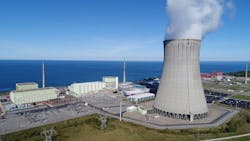Federal GSA Investing in Nuclear Energy through $840M Supply Deal with Constellation
Constellation Energy, which owns the largest fleet of nuclear power reactors in the U.S., has followed its recent headline-grabbing supply deal with Microsoft by gaining more than $1 billion in combined contracts from the U.S. General Services Administration.
The first part is a 10-year, $840 million contract, essentially a nuclear power purchase agreement (PPA), committing Constellation to supplying more than 1 million MWh of nuclear energy to 13 federal government agencies beginning this year. The investment will empower Constellation to expand or uprate capacity at some of its 21 reactors throughout the eastern and midwest U.S.
“Frustratingly, however, nuclear energy was excluded from many corporate and government sustainable energy procurements. Not anymore,” Joe Dominguez, president and CEO of Constellation, said in a statement. “This agreement is another powerful example of how things have changed. Under this agreement, the United States government joins Microsoft and other entities to support continued investment in reliable nuclear energy that will allow Constellation to relicense and extend the lives of these critical assets.”
Nuclear reactors produce carbon-free energy and generate close to 19% of total U.S. utility-scale electricity output annually. The percentage used to be higher, but few new nuclear reactors have been built lately and several facilities have been closed as uneconomical.
Constellation’s 20-year nuclear PPA-type deal reached last year with tech giant Microsoft, however, will enable the refurbishing and restart of the closed Three Mile Island Unit 1 by around 2028. Unit 1, separate from the Unit 2 which suffered a well-known partial meltdown decades ago, was closed a few years ago as utilities predicted flat load growth and the inability for more costly nuclear to compete with cheaper renewable energy and natural gas-fired power generation.
The rise of artificial intelligence modelling and hyperscale data center construction is pushing for a dramatic scaling up of electricity load in coming years. Nuclear energy provides carbon-free power which can help entities reach closer to long-term emissions reduction goals, while also delivering a baseload, flexible and dependable power that intermittent renewables cannot promise.
Under Constellation’s newly announced contract with the U.S. GSA, the nuclear energy will be supplied to the Architect of the Capitol, the General Services Administration, the Social Security Administration, the Army Corps of Engineers, the Department of Veterans’ Affairs, the Department of Transportation, the U.S. Mint, the U.S. Railroad Retirement Board, the National Archives and Records Administration, the Federal Bureau of Prisons, the Federal Reserve System, the National Park Service, the National Oceanic and Atmospheric Administration, and the Washington Metropolitan Area Transit Authority, in locations the agencies own or operate in Illinois, Maryland, New Jersey, Pennsylvania, and Ohio.
Please Follow our LinkedIn page and Join the ET community
In addition to the nuclear version of the PPA, Constellation also gained a $172 million energy savings performance contract to implement energy efficiency and conservation technologies at five GSA-owned facilities in the National Capital Region. The energy savings work will include LED lighting, weatherization, window inserts, new and upgraded HVAC and building control equipment at the Elijah Barrett Prettyman U.S. Courthouse, the William B. Bryant Annex, the Orville Wright Federal Building and the Wilbur Wright Federal Building all located in Washington, DC, and the Harvey W. Wiley Federal Building in College Park, Maryland.
The Three Mile Island Unit 1 will be restarted and renamed the Crane Energy Center, honoring the late Exelon CEO Chris Crane, who was a big proponent of nuclear energy needed to meet environmental goals, and who passed in early 2024.
Constellation’s nuclear power plant fleet includes Braidwood, Byron, Calvert Cliffs, Clinton, Dresden, Fitzpatrick, LaSalle, Limerick and Nine Mile Point, among others.
The new Microsoft deal will reconnect 835 MW of power generation into the PJM Interconnection grid and offset the anticipated demand increase from the data centers. The contract with Microsoft is lucrative enough to justify some $1.6 billion in capital expenditures to revive and restart Three Mile Island Unit 1.
2024 was a big revival year for nuclear energy in the U.S. Southern Co. finally completed its Vogtle Units 3 and 4 expansion, which cost close to $33 billion, while billions of dollars was committed by the federal Department of Energy to the future development of small modular reactor nuclear projects by companies such as X-energy, Oklo and GE-Hitachi Nuclear.
Check out the Microgrid Knowledge Nuclear Microgrids E-Book
Prospects for a Small, Modular and Reactive Future
About the Author
Rod Walton, EnergyTech Managing Editor
Managing Editor
For EnergyTech editorial inquiries, please contact Managing Editor Rod Walton at [email protected].
Rod Walton has spent 17 years covering the energy industry as a newspaper and trade journalist. He formerly was energy writer and business editor at the Tulsa World. Later, he spent six years covering the electricity power sector for Pennwell and Clarion Events. He joined Endeavor and EnergyTech in November 2021.
Walton earned his Bachelors degree in journalism from the University of Oklahoma. His career stops include the Moore American, Bartlesville Examiner-Enterprise, Wagoner Tribune and Tulsa World.
EnergyTech is focused on the mission critical and large-scale energy users and their sustainability and resiliency goals. These include the commercial and industrial sectors, as well as the military, universities, data centers and microgrids. The C&I sectors together account for close to 30 percent of greenhouse gas emissions in the U.S.
He was named Managing Editor for Microgrid Knowledge and EnergyTech starting July 1, 2023
Many large-scale energy users such as Fortune 500 companies, and mission-critical users such as military bases, universities, healthcare facilities, public safety and data centers, shifting their energy priorities to reach net-zero carbon goals within the coming decades. These include plans for renewable energy power purchase agreements, but also on-site resiliency projects such as microgrids, combined heat and power, rooftop solar, energy storage, digitalization and building efficiency upgrades.

